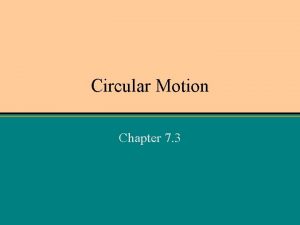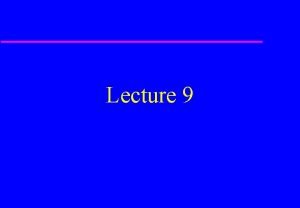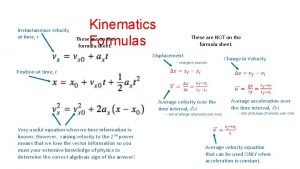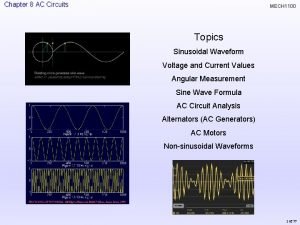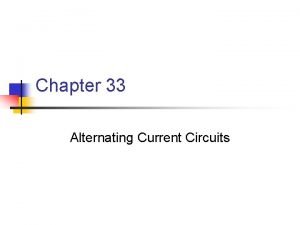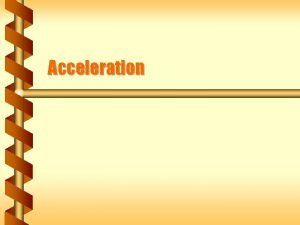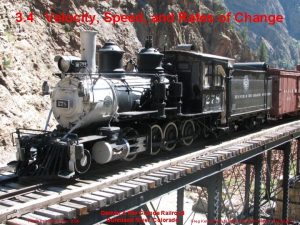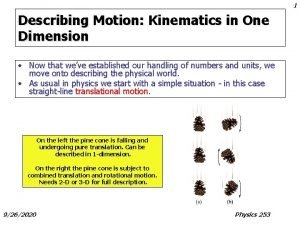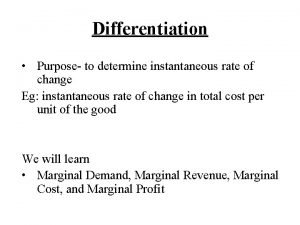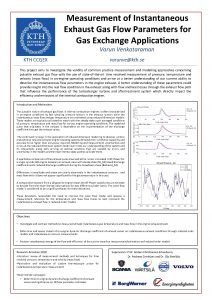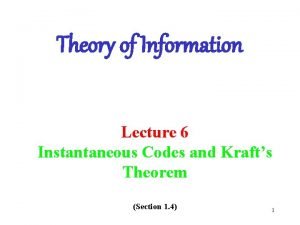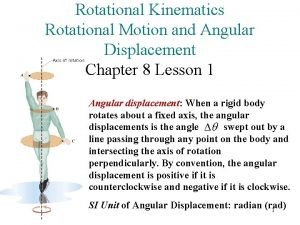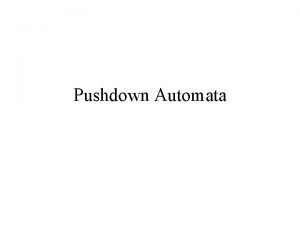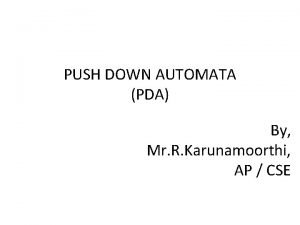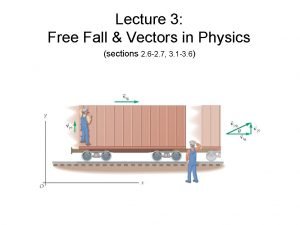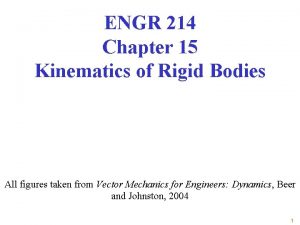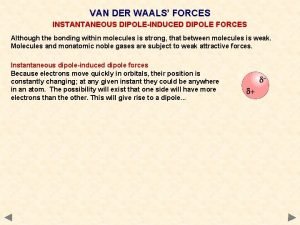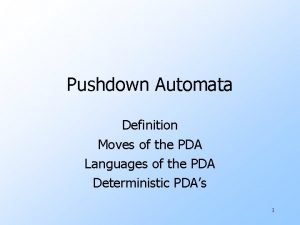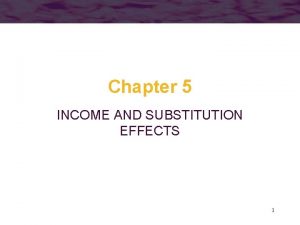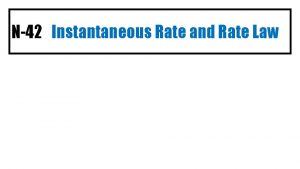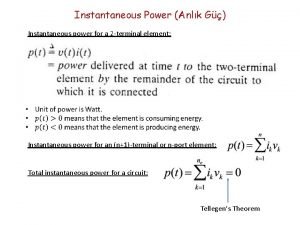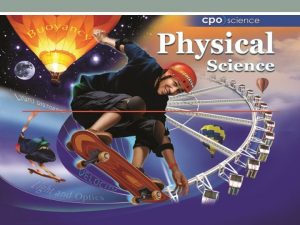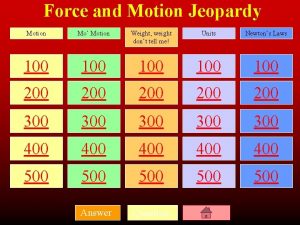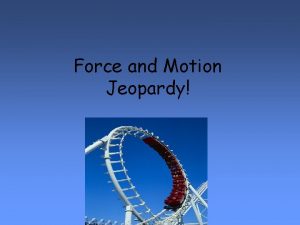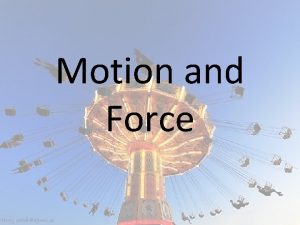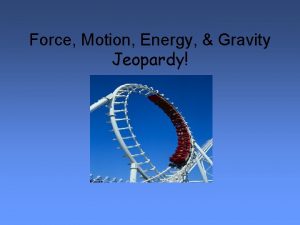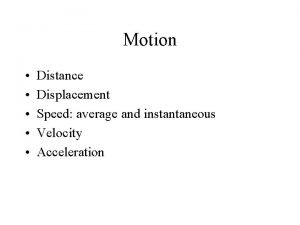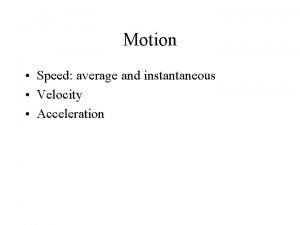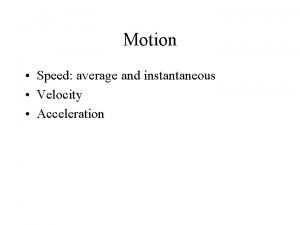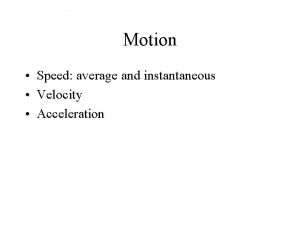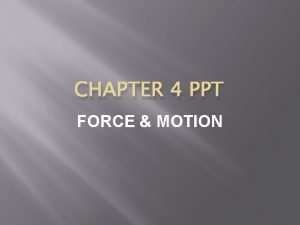Force and Motion Relationships Instantaneous Effect of force
































- Slides: 32

Force and Motion Relationships • Instantaneous Effect of force on motion is to accelerate the object: F=ma • Force applied through a distance: workenergy relationship • Force applied through a time: impulsemomentum relationship

Instantaneous Effect of Force on an Object • Remember the concept of net force? • Need to combine, or add forces, to determine net force • Newton’s third law of motion (F = ma) • Inverse dynamics – estimating net forces from the acceleration of an object • Illustrations from Kreighbaum: Figures F. 4, F. 5, and F. 6 (pp 283 -284)




Force Applied Through a Time: Impulse-Momentum Relationship • • Force applied through a time Impulse - the area under the force-time curve Momentum - total amount of movement (mass x velocity) An impulse applied to an object will cause a change in its momentum (Ft = mv) • Conservation of momentum (collisions, or impacts) – in a closed system, momentum will not change – what is a closed system?

Impulse: area under forcetime curve Impulse produces a change in momentum (m. V)

Vertical impulse While Running: Area under Force-time curve

Anterioposterior (frictional) component of GRF: impulse Is area under Force-time curve Positive and Negative impulse Are equal if Horizontal comp Of velocity is constant

Conservation of momentum: when net impulse is zero (i. e. the system is closed), momentum does not change

Conservation of momentum: is this a closed system?

Force Applied Through a Distance: Work, Power, Energy • Work - force X distance (Newton-meters, or Joules) – On a bicycle: Work = F (2 r X N) – On a treadmill: Work = Weightd X per cent grade • Power - work rate, or combination of strength and speed (Newton-meters/second, or watts) – On a treadmill: P = Weightd X per cent grade/ time – On a bicycle: P = F (2 r X N) / time • What about kilogram-meters/min? • Energy - capacity to do work – kinetic, the energy by virtue of movement (KE = 1/2 mv 2 ) – gravitational potential, energy of position (PE = Weight x height) – elastic potential, or strain, energy of condition (PE = Fd)

Work while pedaling on bicycle: From Mc. Ardle and Katch. Exercise Physiology

Work while running on treadmill: From Mc. Ardle and Katch. Exercise Physiology Note that %grade = tan θ X 100, and tan θ and sin θ are very similar below 20% grade

Calculating Power on a Treadmill • Problem: What is workload (power) of a 100 kg man running on a treadmill at 10% grade at 4 m/s? • Solution: – Power = force x velocity – Force is simply body weight, or 100 x 9. 8 = 980 N – Velocity is vertical velocity, or rate of climbing • Rate of climbing = treadmill speed x percent grade = 4 m/s x. 1 =. 4 m/s – Workload, workrate, or power = 980 N X. 4 m/s = 392 Watts • Note: 4 m/s = 9 mph, or a 6 min, 40 sec mile • Homework: Calculate your workload if you are running on a treadmill set at 5% grade and 5 m/s. – Answer for 200 lb wt is: 223 Watts

Power running up stairs: Work rate = (weight X vertical dist) ÷ time

Conservation of Energy • In some situations, total amount of mechanical energy (potential + kinetic) does not change – Stored elastic energy converted to kinetic energy • • diving board bow (archery) bending of pole in pole vault landing on an elastic object (trampoline) – Gravitational potential energy converted to kinetic energy • Falling objects

Energy conservation – Case I : elastic potential (strain) and kinetic Potential energy (FD) + Kinetic energy (1/2 mv 2) remains constant

Energy conservation – Case II : gravitational potential and kinetic Potential energy (Wh) + kinetic energy (1/2 mv 2) remains constant

Linear Kinetics Formulae

Vector Resolution Problems • Projectile motion situations – Find horizontal velocity – Find vertical velocity • Friction problems – Find horizontal force component (Friction) – Find vertical component (Normal) • First step in adding, or combining vectors – When more than one force is acting on an object – When adding velocity vectors

Vector resolution: Vert comp = F • sin • Θ Horiz comp = F • cos • Θ Θ Θ Vert comp = F • sinΘ Horiz comp = F • cosΘ Θ Θ d Θ Turning comp = F • d • sinΘ Radial comp = F • d • cosΘ ( d = d • sinθ)

Vector Addition Problems • Combining forces – Net effect of two forces applied to any object – What is maximum safe speed for a curve? • Centrifugal force, frictional force, & gravity – What makes a spitball work? • Wind force and weight • Combining velocities – In crossing a river, what direction is best? • Velocity of water and swimmer – In aviation, correcting for wind • air speed and ground speed

Sum of two forces: Sum of two velocities:

(May be deleted if your calculator provides resultant angle in a 0 -360 deg system)


COM Questions • What is COM (or COG) and why is it important? • How is COM location different for infants and how does this affect their movement? • Is COM location different for men vs women? • How is COM different if you lose an arm and how does this affect movement? • How does COM relate to stability? • Why do you lean to one side when carrying a load with one arm? • Can Vince Carter, or any athlete really hang in the air?

COM/COG Concept and Calculation Method (Adrian pp 33 -41) • Center of Mass (COM) • Concept of balancing segmental torques • Segmental Calculation of COM – General calculation method – Information needed • Proportionate mass of each segment • location of COM of each segment

Segmental concept of center of mass


Segmental concept of center of mass

 Instantaneous velocity circular motion
Instantaneous velocity circular motion Cause and effect structure
Cause and effect structure Instantaneous rate of change formula
Instantaneous rate of change formula How to calculate the instantaneous rate of reaction
How to calculate the instantaneous rate of reaction Math calculus
Math calculus Instantaneous velocity
Instantaneous velocity Kinematics formula sheet
Kinematics formula sheet Instantaneous dipole
Instantaneous dipole Drag force ap physics c
Drag force ap physics c Instantaneous voltage formula
Instantaneous voltage formula Instantaneous voltage formula
Instantaneous voltage formula Instantaneous acceleration
Instantaneous acceleration Average rate of change vs instantaneous
Average rate of change vs instantaneous Instantaneous velocity vs average velocity
Instantaneous velocity vs average velocity Refers to the instantaneous rate of change of profit
Refers to the instantaneous rate of change of profit Instantaneous gas flows
Instantaneous gas flows Instantaneous magnitude
Instantaneous magnitude Hopcroft ullman
Hopcroft ullman Instantaneousity
Instantaneousity Angular velocity units
Angular velocity units Instantaneous description of pda
Instantaneous description of pda Pda
Pda Instantaneous description is pda shows
Instantaneous description is pda shows You are adding vectors of length 20 and 40 units.
You are adding vectors of length 20 and 40 units. Plane movement
Plane movement Instantaneous current
Instantaneous current Der
Der Xxxz0
Xxxz0 Chloride shift
Chloride shift Slutsky equation
Slutsky equation What is active rom
What is active rom Founder effect vs bottleneck effect
Founder effect vs bottleneck effect Harmonic equation
Harmonic equation
